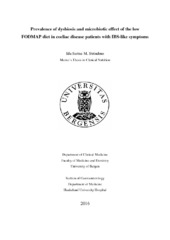| dc.description.abstract | A subgroup of coeliac disease patients have IBS (irritable bowel syndrome)-like symptoms despite following a gluten free diet (GFD). We wanted to compare the microbiota in these patients with an IBS and a healthy population, and look at changes during a low FODMAP (fermentable oligo-, di-, monosaccharides and polyols) diet versus a stricter GFD. We also wanted to look at the effect of diet on symptom relief in these patients. Methods: 40 celiac disease patients with IBS-like symptoms confirmed by the Rome III-criteria and IBS-SSS (symptom severity scale)=75 were compared to Norwegian IBS and healthy cohorts, and randomized into two groups. Group A followed a stricter GFD, whilst patients in group B reduced FODMAPs in their GFD. Both groups followed their diet for six weeks. Faecal samples were collected at baseline and 6 weeks and IBS-SSS at baseline, 3 and 6 weeks. Hydrogen breath test was performed at baseline and after six weeks. The faecal samples were analysed by Genetic Analysis for bacteria and Dysbiosis Index (DI) 1-5, where DI>2 is considered clinically relevant. Statistics: T-test, Mann-Whitney U, RM one way ANOVA, Fisher's linear discriminant analysis. Results: FODMAPs were reduced from 11.5 to 1.6g/day (p=0.0001) in group B, and IBS-SSS score improved in both group A (p=0.0022) and group B (p=0.0001). 45% of the patients had dysbiosis at baseline, compared to 73% in IBS (p=0.0091) and 16% in healthy controls (p=0.0007), with a mean score of 2.5±1.1 versus 3.0±1.0 and 1.7±0.7, respectively. Several bacterial genera were significantly altered at baseline compared to healthy controls, including Bacillus and Prevotella. In group A (18F/2M, age 39±15), dysbiosis stayed constant on diet, but more patients had severe dysbiosis (DI>3), 15% vs. 25% (p=0.85). In group B (15F/5M, age 44±12), fewer patients had dysbiosis after diet, 60% vs. 50% (p=0.79). There was a statistically significant reduction in the genus Bacteroides after the LFD compared to the stricter GFD (p=0.024). Responders to low FODMAP diet (IBS-SSS score reduction >100) had a distinctive microbiota pattern with less Lactobacilli and Firmicutes (Clostridia), and more Atopobium at baseline. There were no reduction in the AUC for hydrogen after six weeks on a low FODMAP diet (p=0.926). Conclusion: Celiac disease patients with IBS- like symptoms had less severe dysbiosis than an IBS-population, but more than healthy controls. This study give evidence for the effect of the low FODMAP diet for symptom relief in these patients. We found that the level of Lactobacilli, Firmicutes (Clostridia) and Atopobium predicted response to the low FODMAP diet. | en_US |
